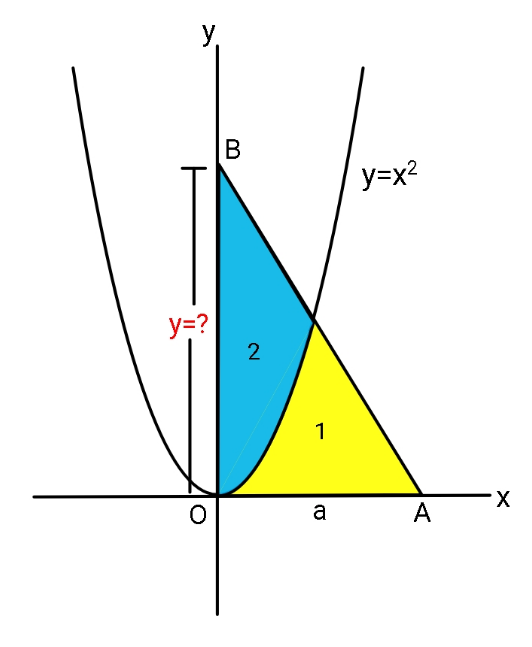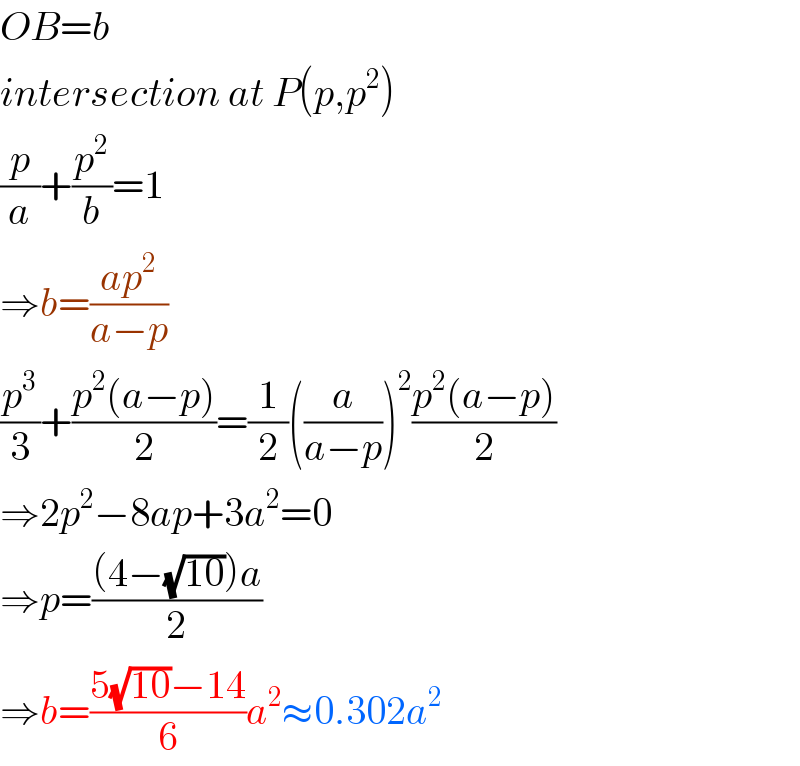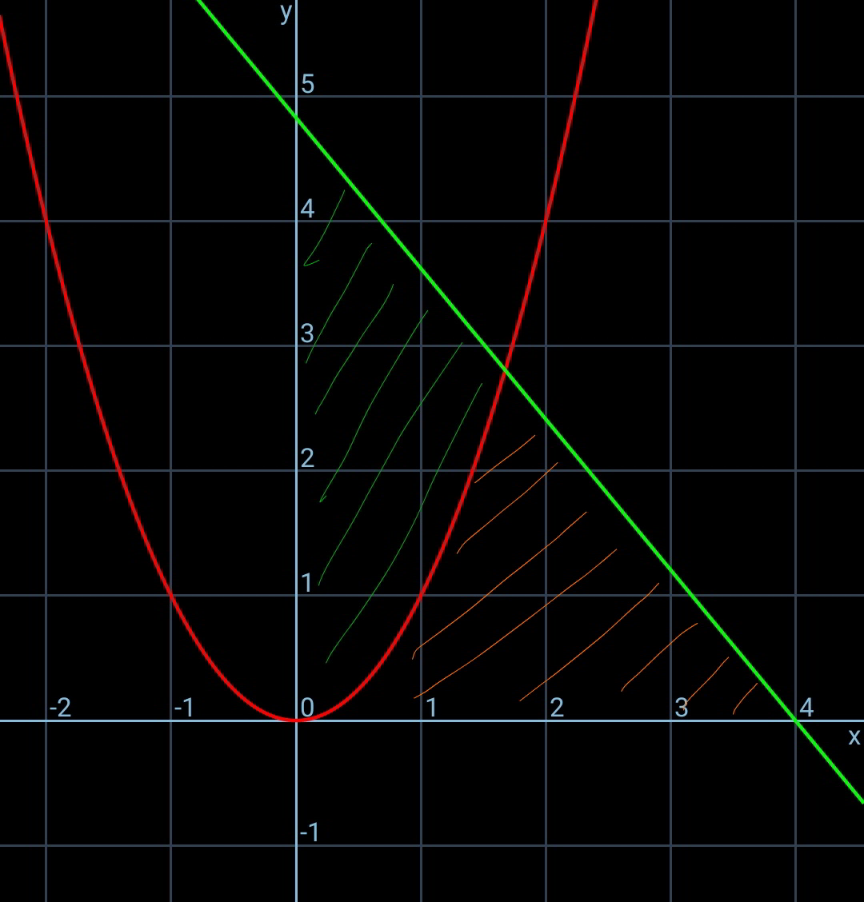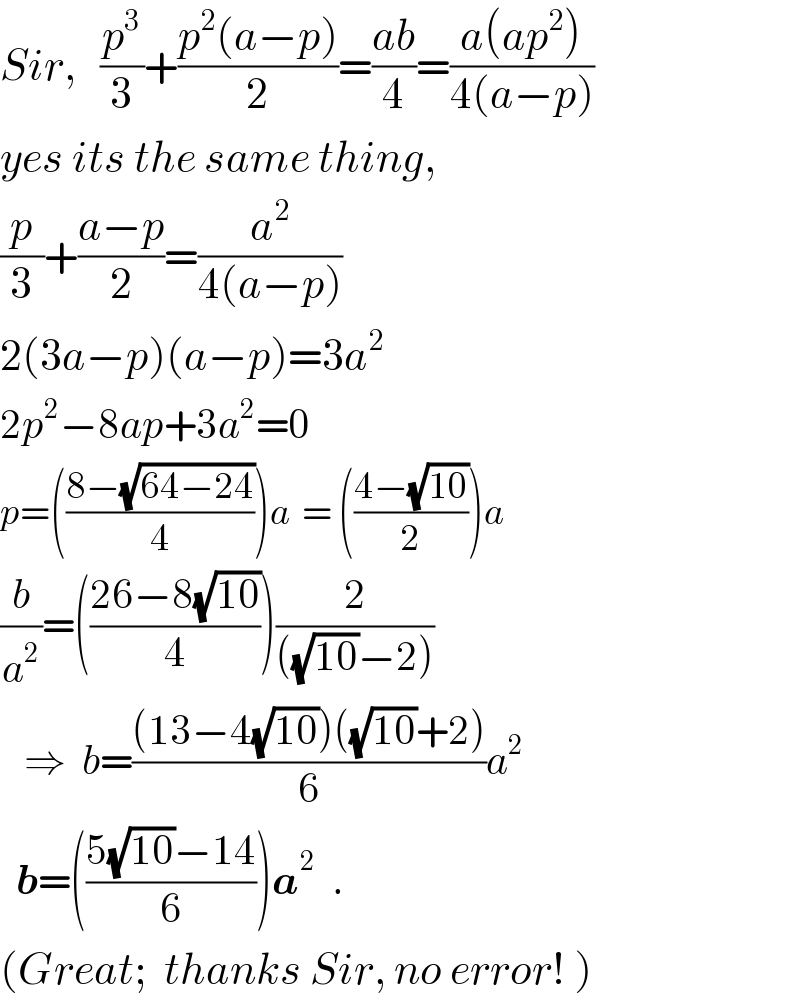Question Number 102838 by ajfour last updated on 11/Jul/20

Commented by ajfour last updated on 11/Jul/20

$${If}\:{regions}\:\mathrm{1}\:{and}\:\mathrm{2}\:{have}\:{equal} \\ $$$${areas},\:{find}\:{OB}={y}\:\:{in}\:{terms}\:{of} \\ $$$${OA}={a}\:. \\ $$
Commented by ajfour last updated on 11/Jul/20

$$\frac{{x}}{{a}}+\frac{{y}}{{b}}=\mathrm{1}\:\:\:\Rightarrow\:\:\:{bx}+{ay}={ab} \\ $$
Answered by mr W last updated on 11/Jul/20

$${OB}={b} \\ $$$${intersection}\:{at}\:{P}\left({p},{p}^{\mathrm{2}} \right) \\ $$$$\frac{{p}}{{a}}+\frac{{p}^{\mathrm{2}} }{{b}}=\mathrm{1} \\ $$$$\Rightarrow{b}=\frac{{ap}^{\mathrm{2}} }{{a}−{p}} \\ $$$$\frac{{p}^{\mathrm{3}} }{\mathrm{3}}+\frac{{p}^{\mathrm{2}} \left({a}−{p}\right)}{\mathrm{2}}=\frac{\mathrm{1}}{\mathrm{2}}\left(\frac{{a}}{{a}−{p}}\right)^{\mathrm{2}} \frac{{p}^{\mathrm{2}} \left({a}−{p}\right)}{\mathrm{2}} \\ $$$$\Rightarrow\mathrm{2}{p}^{\mathrm{2}} −\mathrm{8}{ap}+\mathrm{3}{a}^{\mathrm{2}} =\mathrm{0} \\ $$$$\Rightarrow{p}=\frac{\left(\mathrm{4}−\sqrt{\mathrm{10}}\right){a}}{\mathrm{2}} \\ $$$$\Rightarrow{b}=\frac{\mathrm{5}\sqrt{\mathrm{10}}−\mathrm{14}}{\mathrm{6}}{a}^{\mathrm{2}} \approx\mathrm{0}.\mathrm{302}{a}^{\mathrm{2}} \\ $$
Commented by mr W last updated on 11/Jul/20

Commented by ajfour last updated on 11/Jul/20

$${Sir},\:\:\:\frac{{p}^{\mathrm{3}} }{\mathrm{3}}+\frac{{p}^{\mathrm{2}} \left({a}−{p}\right)}{\mathrm{2}}=\frac{{ab}}{\mathrm{4}}=\frac{{a}\left({ap}^{\mathrm{2}} \right)}{\mathrm{4}\left({a}−{p}\right)} \\ $$$${yes}\:{its}\:{the}\:{same}\:{thing},\: \\ $$$$\frac{{p}}{\mathrm{3}}+\frac{{a}−{p}}{\mathrm{2}}=\frac{{a}^{\mathrm{2}} }{\mathrm{4}\left({a}−{p}\right)} \\ $$$$\mathrm{2}\left(\mathrm{3}{a}−{p}\right)\left({a}−{p}\right)=\mathrm{3}{a}^{\mathrm{2}} \\ $$$$\mathrm{2}{p}^{\mathrm{2}} −\mathrm{8}{ap}+\mathrm{3}{a}^{\mathrm{2}} =\mathrm{0} \\ $$$${p}=\left(\frac{\mathrm{8}−\sqrt{\mathrm{64}−\mathrm{24}}}{\mathrm{4}}\right){a}\:\:=\:\left(\frac{\mathrm{4}−\sqrt{\mathrm{10}}}{\mathrm{2}}\right){a} \\ $$$$\frac{{b}}{{a}^{\mathrm{2}} }=\left(\frac{\mathrm{26}−\mathrm{8}\sqrt{\mathrm{10}}}{\mathrm{4}}\right)\frac{\mathrm{2}}{\left(\sqrt{\mathrm{10}}−\mathrm{2}\right)} \\ $$$$\:\:\:\Rightarrow\:\:{b}=\frac{\left(\mathrm{13}−\mathrm{4}\sqrt{\mathrm{10}}\right)\left(\sqrt{\mathrm{10}}+\mathrm{2}\right)}{\mathrm{6}}{a}^{\mathrm{2}} \\ $$$$\:\:\boldsymbol{{b}}=\left(\frac{\mathrm{5}\sqrt{\mathrm{10}}−\mathrm{14}}{\mathrm{6}}\right)\boldsymbol{{a}}^{\mathrm{2}} \:\:. \\ $$$$\left({Great};\:\:{thanks}\:{Sir},\:{no}\:{error}!\:\right) \\ $$
